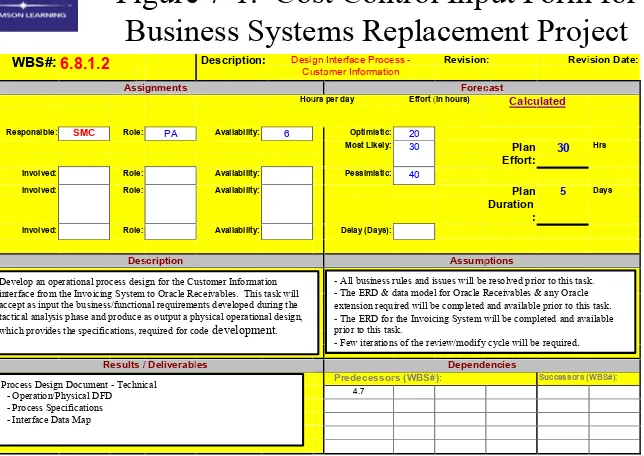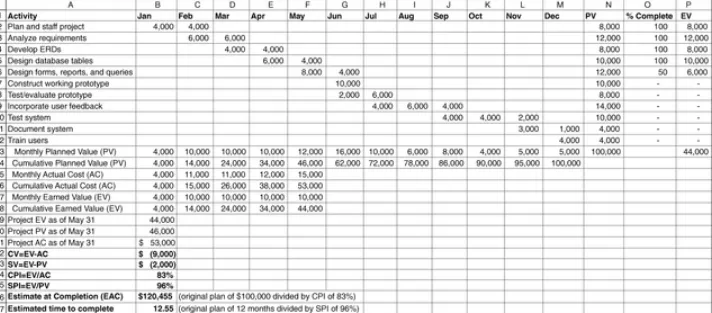Chapter 7:
Learning Objectives
• Understand the importance of good project cost management
• Explain basic project cost management principles, concepts, and terms
• Describe how resource planning relates directly to project cost management
Learning Objectives
• Understand the processes involved in cost
budgeting and preparing a cost estimate for an information technology project
• Understand the benefits of earned value
management and project portfolio management to assist in cost control
The Importance of Project Cost
Management
• IT projects have a poor track record for meeting cost goals
• Average cost overrun from 1995 CHAOS study was 189% of the original estimates; improved to 145% in the 2001 study
What Went Wrong?
According to the San Francisco Chronicle front-page story, "Computer Bumbling Costs the State $1 Billion," the state of California had a series of expensive IT project failures in the late 1990s, costing taxpayers nearly $1 billion…ironic that the state which leads in creation of computers is the
state most behind in using computer technology to improve state services.
…The Internal Revenue Service (IRS) managed a series of project failures that cost taxpayers over $50 billion a year —roughly as much money as the annual net profit of the entire computer industry.
What is Cost and Project Cost
Management?
• Cost is a resource sacrificed or foregone to
achieve a specific objective or something given up in exchange
• Costs are usually measured in monetary units like dollars
Project Cost Management Processes
• Resource planning: determining what resources and quantities of them should be used
• Cost estimating: developing an estimate of the costs and resources needed to complete a
project
• Cost budgeting: allocating the overall cost
estimate to individual work items to establish a baseline for measuring performance
Basic Principles of Cost
Management
• Most CEOs and boards know a lot more about
finance than IT, so IT project managers must speak their language
– Profits are revenues minus expenses
– Life cycle costing is estimating the cost of a project plus the maintenance costs of the products it produces
– Cash flow analysis is determining the estimated annual costs and benefits for a project
– Benefits and costs can be tangible or intangible, direct or indirect
Table 7-1. Cost of Software
Defects
When Defect is Detected Typical Cost of Correction
User Requirements $100-$1,000 Coding/Unit Testing $1,000 or more System Testing $7,000 - $8,000 Acceptance Testing $1,000 - $100,000
After Implementation Up to millions of dollars
Resource Planning
• The nature of the project and the organization will affect resource planning
• Some questions to consider:
– How difficult will it be to do specific tasks on the project?
– Is there anything unique in this project’s scope statement that will affect resources?
– What is the organization’s history in doing similar tasks? – Does the organization have or can they acquire the people,
Sample Headcount Information to
Help Estimate Resource Costs
Cost Estimating
• An important output of project cost management is a cost estimate
• There are several types of cost estimates and tools and techniques to help create them
• It is also important to develop a cost
Table 7-3. Types of Cost
Estimates
Type of Estimate When Done Why Done How Accurate
Rough Order of Magnitude (ROM)
Very early in the project life cycle, often 3–5 years before project completion
Provides rough ballpark of cost for selection decisions
–25%, +75%
Budgetary Early, 1–2 years out Puts dollars in the budget plans
–10%, +25%
Definitive Later in the project, < 1 year out
Provides details for purchases, estimate actual costs
Cost Estimation Tools and Techniques
• 3 basic tools and techniques for cost estimates: – analogous or top-down: use the actual cost of a
previous, similar project as the basis for the new estimate
– bottom-up: estimate individual work items and sum them to get a total estimate
Constructive Cost Model
(COCOMO)
• Barry Boehm helped develop the COCOMO models for estimating software development costs
• Parameters include source lines of code or function points
• COCOMO II is a computerized model available on the Web
• Boehm suggests that only parametric models do not suffer from the limits of human
Typical Problems with IT Cost
Estimates
• Developing an estimate for a large software project is a complex task requiring a significant amount of effort.
Remember that estimates are done at various stages of the project
• Many people doing estimates have little experience doing them. Try to provide training and mentoring
• People have a bias toward underestimation. Review estimates and ask important questions to make sure estimates are not biased
Table 7-5. Business Systems Replacement Project Cash Flow Analysis
FY95
60% Discount (595) (595)
Oracle Credits (397) 0 (397)
Net Cash for Software 0 500 500
Software Maintenance 0 90 250 340 250
Hardware & Maintenance 0 270 270 540 270
Consulting &Training 205 320 0 525 0
Tax & Acquisition 0 150 80 230 50
Total Purchased Costs 205 1330 600 2135 570
Information Services & Technology (IS&T)
500 1850 1200 3550 0
Finance/Other Staff 200 990 580 1770
Total Costs 905 4170 2380 7455 570
Savings
Mainframe (101) (483) (584) (597)
Finance/Asset/PM (160) (1160) (1320) (2320)
IS&T Support/Data Entry (88) (384) (472) (800)
Interest 0 (25) (25) (103)
Total Savings (349) (2052) (2401) (3820)
Net Cost (Savings) 905 3821 328 5054 (3250)
8 Year Internal Rate of Return
Cost Budgeting
• Cost budgeting involves allocating the project cost estimate to individual work items and
providing a cost baseline
• For example, in the Business Systems
Replacement project, there was a total purchased cost estimate for FY97 of $600,000 and another $1.2 million for Information Services and
Technology
Table 7-6. Business Systems Replacement Project Budget Estimates for FY97 and Explanations
Budget Category Estimated Costs Explanation
Headcount (FTE) 13 Included are 9 programmer/analysts, 2
database analysts, 2 infrastructure technicians.
Compensation $1,008,500 Calculated by employee change notices
(ECNs) and assumed a 4% pay increase in June. Overload support was planned at $10,000.
Consultant/Purchased Services
$424,500 Expected consulting needs in support of the Project Accounting and Cascade
implementation efforts; maintenance expenses associated with the Hewlett-Packard (HP) computing platforms; maintenance expenses associated with the software purchased in support of the BSR project.
Travel $25,000 Incidental travel expenses incurred in
support of the BSR project, most associated with attendance of user conferences and off-site training.
Depreciation $91,000 Included is the per head share of
workstation depreciation, the Cascade HP platform depreciation, and the depreciation expense associated with capitalized
software purchases.
Rents/Leases $98,000 Expenses associated with the Mach1
computing platforms. Other Supplies
and Expenses
$153,000 Incidental expenses associated with things such as training, reward and recognition, long distance phone charges, miscellaneous office supplies.
Cost Control
• Project cost control includes – monitoring cost performance
– ensuring that only appropriate project changes are included in a revised cost baseline
– informing project stakeholders of authorized changes to the project that will affect costs
Earned Value Management (EVM)
• EVM is a project performance measurement technique that integrates scope, time, and cost data
• Given a baseline (original plan plus approved changes), you can determine how well the
project is meeting its goals
Figure 7-1. Cost Control Input Form for Business Systems Replacement Project
WBS#:6.8.1.2 Description: Design Interface Process -Customer Information
Revision: Revision Date:
Assignments Forecast
Hours per day Effort (in hours) Calculated
Responsible: SMC Role: PA Availability: 6 Optimistic: 20
Most Likely: 30 Plan
Effort: 30
Hrs
Involved: Role: Availability: Pessimistic: 40
Involved: Role: Availability: Plan
Duration :
5 Days
Involved: Role: Availability: Delay (Days):
Description Assumptions
Results / Deliverables Dependencies
Predecessors (WBS#): Successors (WBS#):
4.7
Develop an operational process design for the Customer Information interface from the Invoicing System to Oracle Receivables. This task will accept as input the business/functional requirements developed during the tactical analysis phase and produce as output a physical operational design, which provides the specifications, required for code development.
Process Design Document - Technical - Operation/Physical DFD
- Process Specifications - Interface Data Map
- All business rules and issues will be resolved prior to this task. - The ERD & data model for Oracle Receivables & any Oracle extension required will be completed and available prior to this task. - The ERD for the Invoicing System will be completedand available prior to this task.
- Few iterations of the review/modify cycle will berequired.
Earned Value Management Terms
• The planned value (PV), formerly called the budgeted
cost of work scheduled (BCWS), also called the budget, is that portion of the approved total cost
estimate planned to be spent on an activity during a given period
• Actual cost (AC), formerly called actual cost of work performed (ACWP), is the total of direct and indirect costs incurred in accomplishing work on an activity during a given period
• The earned value (EV), formerly called the budgeted
Rules of Thumb for Earned Value
Numbers
• Negative numbers for cost and schedule
variance indicate problems in those areas. The
project is costing more than planned or taking longer than planned
Project Portfolio Management
• Many organizations collect and control an entire suite of projects or investments as one set of interrelated activities in a portfolio
• Five levels for project portfolio management – Put all your projects in one database
– Prioritize the projects in your database
– Divide your projects into two or three budgets based on type of investment
– Automate the repository
Using Software to Assist in Cost
Management
• Spreadsheets are a common tool for resource planning, cost estimating, cost budgeting, and cost control
• Many companies use more sophisticated and centralized financial applications software for cost information


